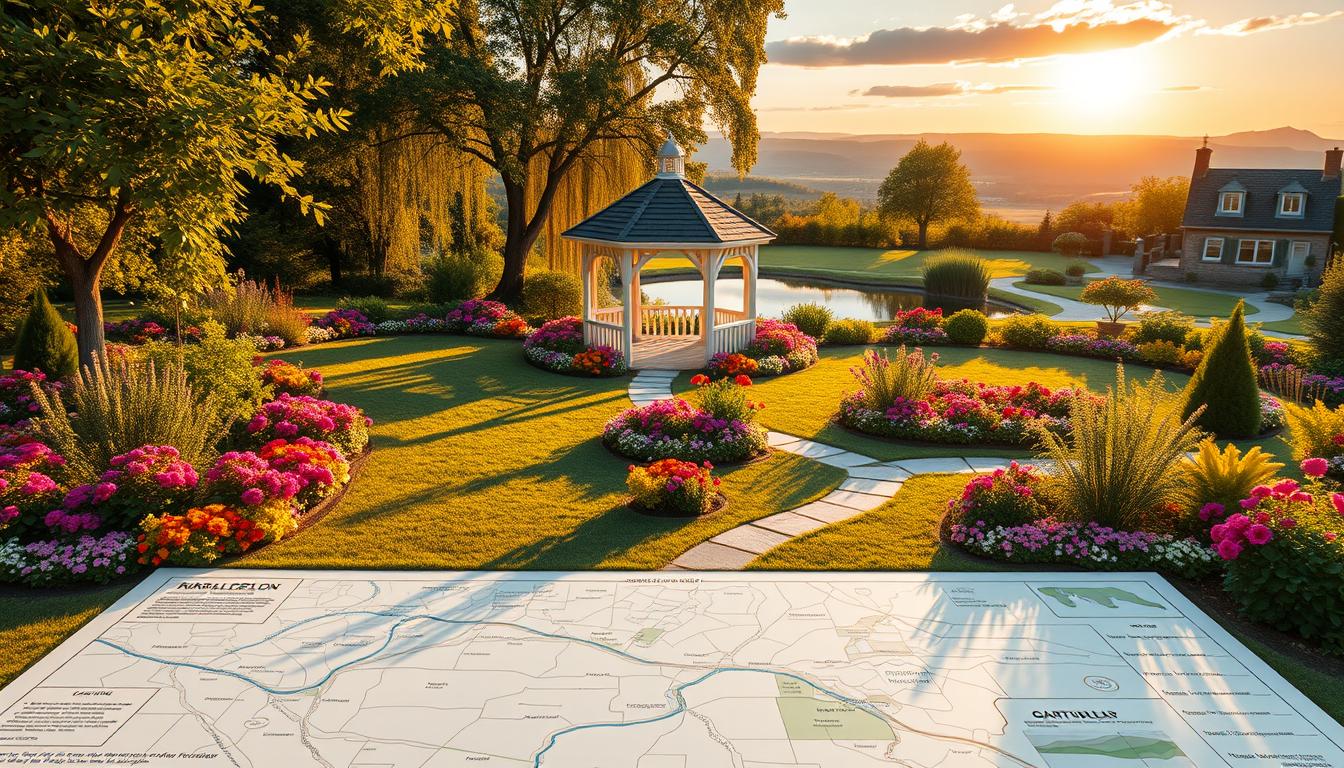Winter is the perfect time to dream about spring and start planning your outdoor space. For families looking for a creative activity, designing a garden plan can be both fun and productive. Using a garden map template simplifies the process, especially for beginners who want to start small.
Free printable templates are available to help you structure your layout. Whether you’re focusing on a single bed or a larger area, these tools act as a roadmap for planting. For example, placing tomatoes, peppers, and herbs together can maximize ingredients for salsa or pizza.
Timing is also crucial. With growing seasons lasting 100-150 days, strategic planning ensures your plants thrive. A well-thought-out plan saves time and makes the most of your space, no matter the season.
Key Takeaways
- Winter is a great time to plan your outdoor space for spring.
- Use templates to simplify the design process, especially for beginners.
- Free printable options provide structured layouts for easy planning.
- Strategic plant placement maximizes productivity and convenience.
- Consider growing seasons to ensure your plants thrive.
Introduction to Garden Map Templates
Designing your outdoor area starts with a clear vision and the right tools. A garden map acts as a “plant blueprint,” combining functionality and creativity. It’s a scaled drawing that outlines where to place veggies, herbs, or flowers for optimal growth.
There are different ways to create these layouts. Some prefer structured grids for precision, while others enjoy hand-drawn designs for a personal touch. For example, kids’ templates often encourage artistic freedom, making the process fun and educational.

These templates are incredibly diverse. You can focus on a vibrant flower bed or a practical kitchen setup. Each layout is unique, reflecting your preferences and the specifics of your space. As the saying goes, “No two maps look alike.”
To get started, you’ll need basic tools like graph paper and colored pencils. For a digital approach, apps like EdrawMax offer detailed templates for various designs. Whether you’re a beginner or an expert, these tools make planning your outdoor area simple and enjoyable.
Why Use a Garden Map Template?
Simplify your outdoor design with a structured approach. A well-thought-out plan helps you avoid common pitfalls and ensures your plants thrive. Whether you’re a beginner or an experienced gardener, these tools make the process smoother and more enjoyable.
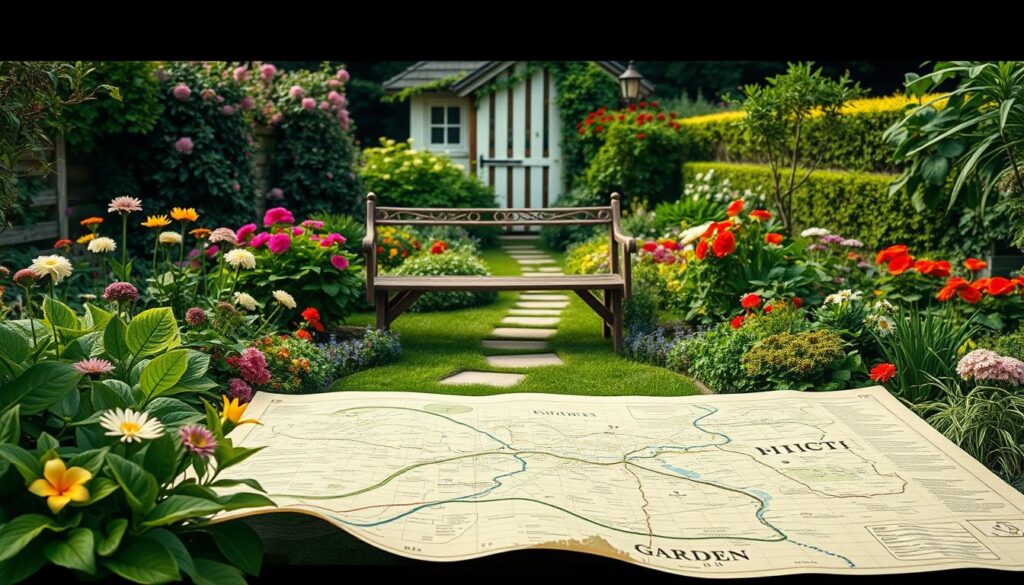
Benefits of Garden Mapping
Using a structured layout reduces stress and sets realistic expectations. It helps you track crop rotations, ensuring your soil stays healthy year after year. With a clear plan, you can also control your budget by creating a seed list in advance.
One of the biggest challenges is overcrowding. We all want to grow everything, but space is limited. A pre-planned layout prevents this issue, saving you time and effort. It also helps you avoid mistakes, like planting incompatible species together.
For example, tomatoes and basil are great companions, while others may compete for resources. Tracking progress is another advantage. Printable logs let you record seedlings, harvests, and plant details, making it easier to learn and improve.
Zone-specific success is another key benefit. Gardeners in Zone 3, with shorter growing seasons, rely on these tools to maximize their time. By aligning your plan with your zone, you can ensure your plants thrive in the right conditions.
| Benefit | Description |
|---|---|
| Reduces Stress | Pre-planned layouts set realistic expectations and simplify decisions. |
| Saves Time | Structured designs prevent overcrowding and spring decision fatigue. |
| Avoids Mistakes | Companion planting guidance ensures plants grow harmoniously. |
| Tracks Progress | Printable logs help record seedlings, harvests, and plant details. |
| Zone-Specific Success | Aligns planting with local growing conditions for better results. |
Getting Started with Your Garden Map
Planning your outdoor area begins with understanding your space and needs. Before diving into planting, take time to assess your available area and make informed decisions. This step ensures your plants thrive and your layout works efficiently.
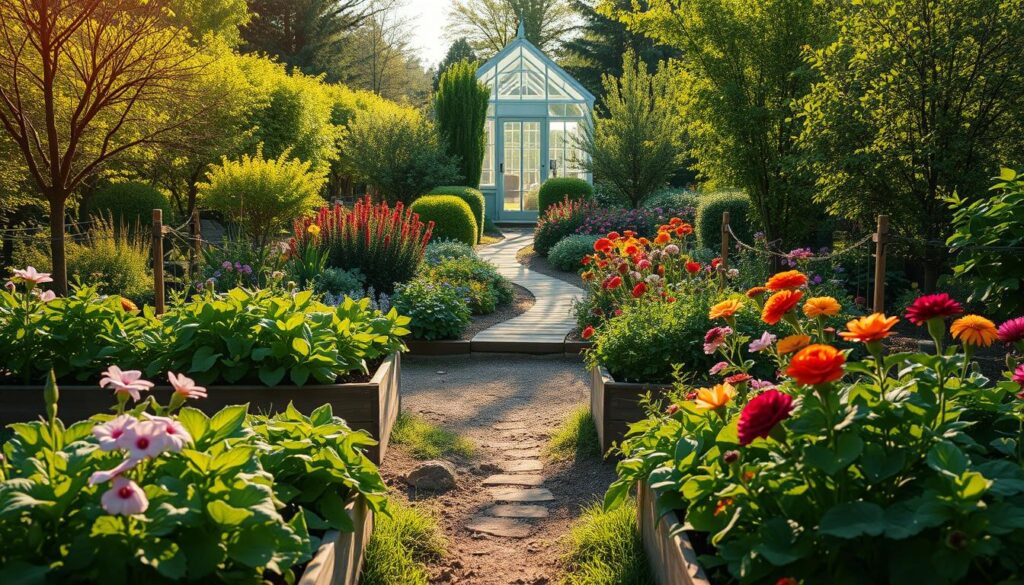
Assessing Your Garden Space
Start by measuring your outdoor area. Use a simple scale like “1 inch = 1 foot” to create a proportional layout. This helps you visualize how much space each plant or bed will occupy.
Next, test your soil. Nutrient-rich soil is essential for healthy plants. Consider using organic recipes to enhance soil quality. For example, adding compost can improve texture and fertility.
Don’t forget to map sun and shade patterns. Some plants, like lettuce, thrive in partially shady areas, while others need full sunlight. Understanding these patterns ensures you place each plant in the right spot.
Choosing What to Plant
Select plants your family loves to eat. This makes the process rewarding and practical. For beginners, start with easy-to-grow crops like tomatoes, peppers, or herbs.
When sourcing seeds, consider reputable suppliers like Baker Creek Heirloom Seeds. They offer high germination rates and a wide variety of options. This ensures your plants start strong.
Finally, consider your hardiness zone. This info helps you choose plants suited to your local climate. For example, gardeners in Zone 3 with shorter growing seasons should select crops that mature quickly.
“The right plants in the right place make all the difference.”
| Step | Action |
|---|---|
| 1 | Measure your outdoor area using a proportional scale. |
| 2 | Test and improve soil quality for optimal plant growth. |
| 3 | Map sun and shade patterns to place plants strategically. |
| 4 | Choose family-friendly crops and source high-quality seeds. |
| 5 | Consider your hardiness zone for climate-appropriate plants. |
For more gardening for beginners tips, explore our detailed guide. These steps will help you create a thriving outdoor space tailored to your needs.
Creating Your Garden Map Template
Bring your outdoor vision to life with a well-crafted layout. Whether you’re a beginner or an experienced planner, having the right tools and ideas makes the process smoother and more enjoyable. Let’s dive into the essentials for creating a functional and beautiful plan.
Tools You’ll Need
Start with the basics: graph paper, a pencil, and a ruler. These traditional tools help you sketch out your area with precision. For a creative touch, use colored pencils to color-code veggies, herbs, or flowers. This visual approach makes it easier to organize your design.
If you prefer a digital approach, apps like EdrawMax offer over 26,000 symbols for trees, fences, and ponds. These features allow you to create detailed and professional layouts without the hassle of hand-drawing. Whether you’re working on a small bed or a larger space, these tools simplify the process.

Designing Your Garden Layout
Once you have your tools, it’s time to focus on the design. Start by dividing your space into 4 sq. ft grids. This step helps you allocate the right amount of room for each plant. For example, carrots need less space than pumpkins, so plan accordingly.
Consider using the Three Sisters planting method, which combines corn, beans, and squash for mutual benefits. This example of companion planting maximizes space and resources. Mark succession spots for 2-3 crop rotations to keep your soil healthy and productive.
Here’s a quick checklist to guide your plan:
- Color-code plants for easy organization.
- Use grids to ensure proper spacing.
- Mark succession spots for crop rotations.
- Laminate kids’ watercolor maps for durability.
With these ideas, you’ll create a layout that’s both practical and visually appealing. A well-thought-out plan ensures your plants thrive and your space looks amazing.
Types of Garden Map Templates
Crafting a layout for your outdoor area can be both creative and practical. Whether you’re designing a vibrant flower setup or a functional vegetable plot, the right template makes the process easier. Let’s explore the two main types: flower and vegetable layouts.
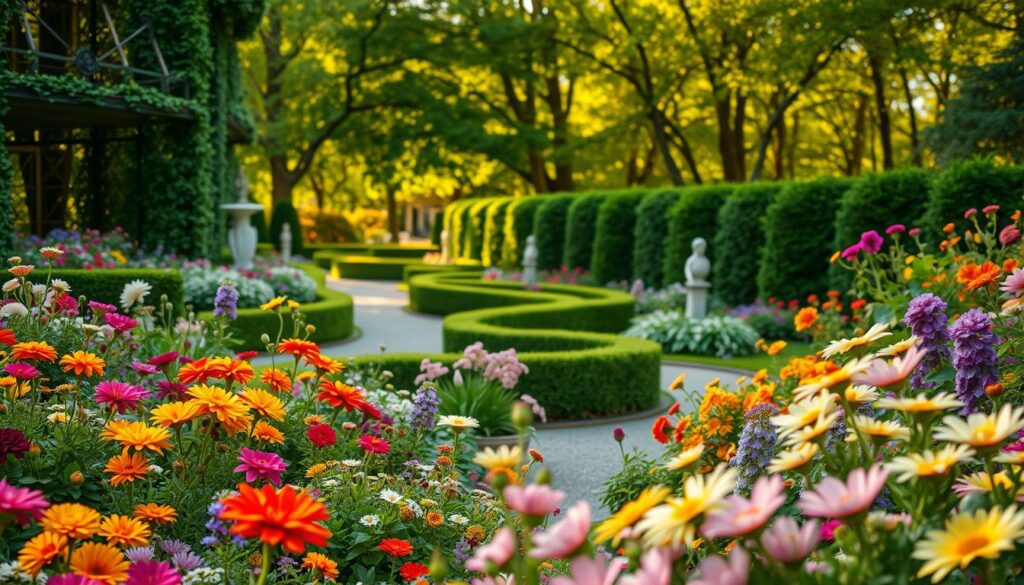
Flower Garden Templates
Flower designs often focus on aesthetics and functionality. For example, you can include ponds or benches to create a relaxing space. These layouts are perfect for those who want to enjoy nature while adding beauty to their outdoor area.
Consider using pollinator-friendly plants like marigolds beside peppers. This not only enhances the look but also supports local wildlife. For a striking centerpiece, try “Pink Brandywine tomatoes” surrounded by colorful blooms.
Vegetable Garden Templates
Vegetable layouts are all about efficiency and productivity. The “four square” nutrient zoning method is a great example. It divides the space into sections, each dedicated to specific plants based on their nutrient needs.
For kitchen setups, place herbs by the back door for easy access. Taller crops like corn should be positioned north-south to avoid shading smaller plants. Don’t forget to mark vertical spaces for trellises, ideal for cucumbers or beans.
These templates ensure your outdoor area is both beautiful and productive. For more inspiration, check out our guide on boho farmhouse decor to complement your design.
Tips for Successful Garden Planning
Mastering the art of planting requires thoughtful planning and smart strategies. Whether you’re a beginner or an experienced gardener, these tips will help you create a thriving and sustainable space.
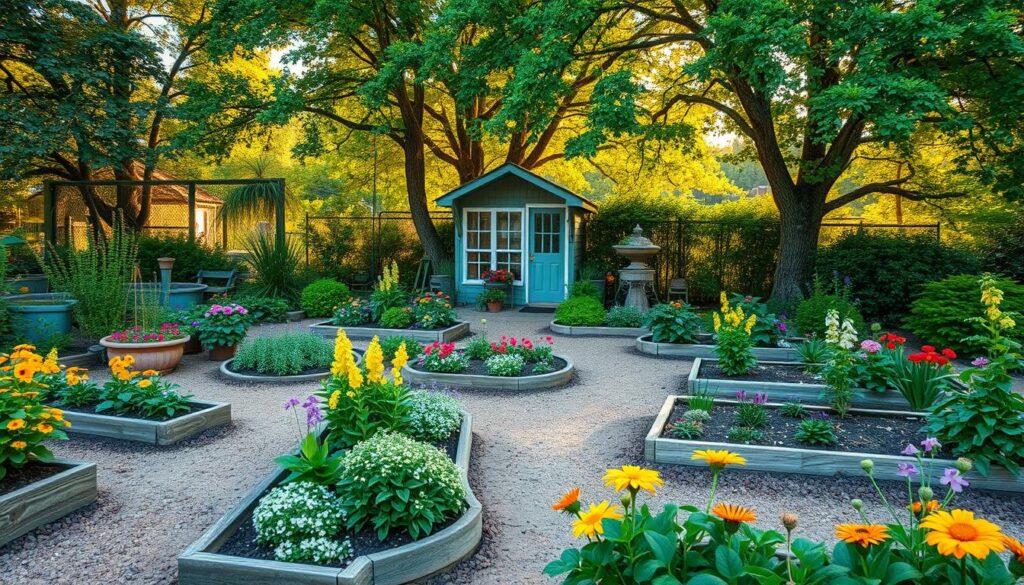
Crop Rotation and Companion Planting
One essential step is crop rotation. Moving plants like tomatoes to new beds each year prevents soil depletion and reduces pest issues. A 3-year rotation cycle is ideal for maintaining soil health.
Companion planting is another smart strategy. For example, basil repels flies when planted near tomatoes. This natural pest control method keeps your plants healthy without chemicals.
Succession Planting Strategies
Succession planting maximizes your space and extends your growing season. Start with cool-weather crops like lettuce before transitioning to heat-lovers like peppers. This ensures a continuous harvest.
Interplanting is another effective technique. For example, radishes grow quickly between slower crops like carrots. This makes the most of your space and time.
Track your progress with tools like Annette’s “9-page printables” for harvest logs. These help you monitor what works and improve your planning for future years.
“Smart planting strategies lead to healthier plants and a more productive space.”
Conclusion
Creating a thriving outdoor space doesn’t have to be overwhelming. Start small with one bed and let your creativity grow. Frame your kids’ watercolor designs for a personal touch that adds charm to your plan.
Engage with the community by sharing your layouts on Instagram. Tag @azurefarm for feedback and inspiration. This collaborative approach makes the process even more enjoyable.
Your plan isn’t just for spring. Update it for fall garlic or spring bulbs to make the most of every season. Keep your design on the fridge for daily reference and easy adjustments.
Ready to get started? Download free templates or try EdrawMax for a seamless experience. With these tools, your outdoor space will flourish year after year.

